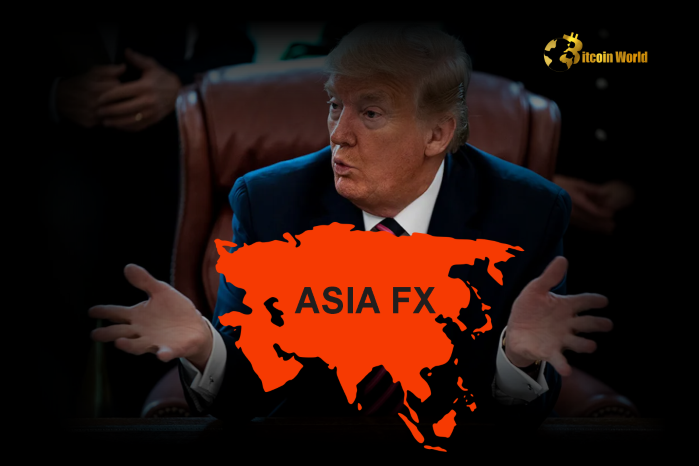Turbulent Times: Trump Tariffs Crush Asia FX as Yen Soars on Safe Haven Appeal
0
0

Buckle up, folks, because the forex markets are experiencing a wild ride! Donald Trump’s tariff policies are sending shockwaves across Asia, leaving Asian currencies reeling and the mighty US dollar battered. But amidst this financial storm, there’s a beacon of stability: the Japanese Yen. Why is the Yen surging while other currencies stumble? Let’s dive deep into the factors driving these dramatic currency shifts and what it means for you.
How Trump Tariffs Are Battering Asian Currencies?
President Trump’s trade policies, characterized by aggressive tariffs, are significantly impacting Asian economies and their respective currencies. These tariffs, primarily aimed at China but affecting the entire region, create uncertainty and disrupt established trade flows. Here’s a breakdown of how these tariffs are causing turmoil:
- Reduced Exports: Tariffs increase the cost of goods exported from Asian countries to the US. This directly reduces the demand for Asian products, hurting export-oriented economies.
- Supply Chain Disruptions: Asian economies are deeply integrated into global supply chains. Tariffs disrupt these chains, forcing businesses to reconsider production locations and strategies, often leading to economic slowdown.
- Investor Sentiment: Trade wars breed uncertainty. Investors become wary of investing in Asian markets, leading to capital outflows and weakening currencies.
- Currency Devaluation Pressure: To remain competitive despite tariffs, some Asian nations might face pressure to devalue their currencies, further adding to market volatility.
Consider these examples to understand the tangible impact:
| Asian Currency | Impact of Tariffs |
|---|---|
| Chinese Yuan (CNY) | Directly impacted by US tariffs on Chinese goods. Faces devaluation pressure and capital outflow risks. |
| South Korean Won (KRW) | Vulnerable due to South Korea’s export-dependent economy and its position in global supply chains. |
| Singapore Dollar (SGD) | Affected by regional economic slowdown and reduced trade flows within Asia. |
| Indian Rupee (INR) | Indirectly impacted through global economic uncertainty and shifts in investor sentiment towards emerging markets. |
Why is the US Dollar Under Pressure?
While seemingly counterintuitive, Trump’s tariffs are also putting pressure on the US dollar. Here’s why:
- Retaliatory Tariffs: Other countries, including those in Asia, have retaliated against US tariffs by imposing their own tariffs on American goods. This hurts US exports and can weaken the dollar.
- Economic Uncertainty in the US: Trade wars create economic uncertainty within the US as well. Businesses face higher input costs and reduced export opportunities, potentially slowing down economic growth and impacting the dollar.
- Federal Reserve Policy: While not directly tariff-related, the Federal Reserve’s monetary policy decisions are influenced by the overall economic outlook. Trade uncertainty can lead to adjustments in interest rate expectations, affecting the dollar’s value.
- Global Economic Slowdown Fears: Tariffs contribute to fears of a global economic slowdown. In such scenarios, investors may seek safe-haven assets other than the US dollar, diversifying away from it.
The dollar’s strength is often seen as a barometer of global economic confidence. When trade tensions rise, and global growth prospects dim, even the world’s reserve currency can feel the heat.
Japanese Yen: The Ultimate Safe Haven Asset?
In times of economic turmoil and market volatility, investors often flock to safe-haven assets. And in the forex world, the Japanese Yen has historically been considered a premier safe haven. But what makes the Yen so attractive during crises?
- Japan’s Net Creditor Status: Japan is a net creditor nation, meaning it holds more overseas assets than liabilities. In times of global stress, there’s an expectation that Japanese investors will repatriate their funds, increasing demand for the Yen.
- Low Interest Rates: Japan has maintained low interest rates for a long time. This makes the Yen a less attractive currency for borrowing and speculation, reducing downward pressure during crises.
- Political Stability: Despite economic challenges, Japan is perceived as a politically stable nation. This stability is a key factor for investors seeking refuge from global uncertainties.
- Deep and Liquid Markets: Japan boasts deep and liquid financial markets. This allows for large volumes of Yen trading without causing significant price distortions, enhancing its appeal as a safe haven.
The surge in the Japanese Yen amidst the Trump tariff-induced market turbulence is a classic example of its safe-haven appeal in action. Investors are prioritizing safety and stability, and the Yen fits the bill perfectly.
What Does This Mean for Forex Markets and Traders?
The current situation presents both challenges and opportunities for forex market participants. Here’s what you need to consider:
- Increased Volatility: Expect heightened volatility in Asian currencies and potentially the US dollar. Trade tensions and policy uncertainties can lead to sudden and sharp currency movements.
- Yen Strength Opportunities: The Yen’s safe-haven status could present trading opportunities. Monitor Yen pairs closely for potential long positions during periods of market stress.
- Risk Management is Crucial: With increased volatility, robust risk management strategies are more important than ever. Use stop-loss orders and manage your leverage carefully.
- Stay Informed: Keep a close watch on trade policy developments, economic data releases, and central bank announcements. These factors will heavily influence currency movements.
- Diversification: Consider diversifying your forex portfolio beyond just major currency pairs. Exploring crosses involving safe-haven currencies like the Swiss Franc (CHF) or gold (XAU) might be prudent.
For traders, navigating these turbulent waters requires a blend of caution and strategic thinking. Understanding the underlying drivers of currency movements and adapting to the evolving global economic landscape is key to success.
Actionable Insights: Navigating Currency Fluctuations in a Tariff-Driven World
So, how can you, as an informed individual or investor, navigate these choppy currency markets influenced by tariffs and trade tensions? Here are some actionable insights:
- Monitor Trade Policy Updates: Stay informed about the latest developments in trade policies and tariff announcements. Reputable financial news sources and economic calendars are invaluable tools.
- Analyze Economic Indicators: Pay attention to key economic indicators from Asian economies, the US, and Japan. GDP growth, inflation, and trade balances can provide clues about currency direction.
- Understand Central Bank Responses: Central banks often react to economic shocks and currency fluctuations. Monitor statements and policy decisions from the Federal Reserve, Bank of Japan, and Asian central banks.
- Seek Professional Advice: If you’re unsure about how to manage currency risk, consider consulting with a financial advisor or forex expert. Personalized guidance can be beneficial.
- Educate Yourself Continuously: The forex market is dynamic. Continuously learning about global economics, geopolitics, and technical analysis will enhance your understanding and decision-making.
In this era of trade disputes and currency volatility, knowledge is your most powerful asset. By staying informed, being adaptable, and employing sound risk management practices, you can navigate the forex markets with greater confidence.
Conclusion: Riding the Forex Rollercoaster
The global forex market is currently experiencing a rollercoaster ride, largely driven by Trump’s tariff policies. Asian currencies are feeling the pain, the US dollar is under pressure, and the Japanese Yen is shining as a safe haven. This dynamic environment presents both challenges and opportunities. By understanding the forces at play and adopting a strategic approach, you can navigate these turbulent times and potentially capitalize on the shifts in the currency landscape. The key is to stay informed, manage risk wisely, and be prepared for further volatility as the global trade narrative continues to unfold.
To learn more about the latest Forex market trends, explore our article on key developments shaping currency liquidity.
0
0
 Manage all your crypto, NFT and DeFi from one place
Manage all your crypto, NFT and DeFi from one placeSecurely connect the portfolio you’re using to start.




